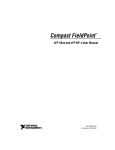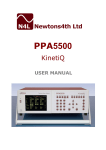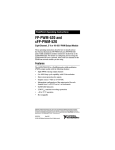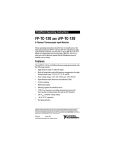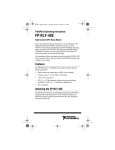Download cFP-RLY-423 Operating Instructions
Transcript
FieldPoint™ Operating Instructions cFP-RLY-423 Four-Channel SPDT Relay Module These operating instructions describe how to install and use the National Instruments cFP-RLY-423. For more information about configuring and accessing the cFP-RLY-423 over a network, refer to the user manual for the FieldPoint network module you are using. Features The cFP-RLY-423 is a Compact FieldPoint relay output module with the following features: • Four single-pole double-throw (SPDT) relay channels • Switches up to 1.5 A at 35 VDC or 250 VAC • LED relay status indicators • Hot swappable • –40 to 60 °C operation • 250 Vrms maximum isolation voltage • 2,300 Vrms transient overvoltage protection Installing the cFP-RLY-423 The cFP-RLY-423 mounts on a Compact FieldPoint backplane (cFP-BP-x), which provides operating power to the module. Installing the cFP-RLY-423 onto a powered backplane does not disrupt the operation of the bank. To install the cFP-RLY-423, refer to Figure 1 and complete the following steps: 1. Align the captive screws on the cFP-RLY-423 with the holes on the backplane. The alignment keys on the cFP-RLY-423 prevent backward insertion. 2. Press firmly to seat the cFP-RLY-423 on the backplane. 3. Using a number 2 Phillips screwdriver with a shank of at least 64 mm (2.5 in.) length, tighten the captive screws to 1.1 N ⋅ m (10 lb ⋅ in.) of torque. The nylon coating on the screws prevents them from loosening. 4 3 5 2 4 2 1 1 cFP I/O Module 2 Captive Screws 3 cFP Controller Module 4 Screw Holes 5 cFP Backplane Figure 1. Installing the cFP-RLY-423 cFP-RLY-423 2 ni.com Wiring the cFP-RLY-423 The cFP-CB-x connector block has connections for each of the four cFP-RLY-423 relay channels and for an external supply to power field devices. If you are using the cFP-RLY-423 in a hazardous voltage application, you must use the cFP-CB-1 connector block or a suitable hazardous voltage cable. A hazardous voltage is a voltage greater than 42.4 Vpeak or 60 VDC. Ensure that hazardous voltage wiring is performed only by qualified personnel adhering to local electrical standards. Caution Each relay channel of the cFP-RLY-423 has four terminals: one NO (normally open), one NC (normally closed), and two IC (isolated common). Table 1 lists the terminal assignments for the signals of each channel. Table 1. Terminal Assignments Terminal Numbers Channel NO IC NC 0 1 2,3 4 1 5 6,7 8 2 9 10,11 12 3 13 14,15 16 All of the COM terminals are connected internally and all of the VSUP terminals are connected internally. NI does not recommend using them with the cFP-RLY-423. © National Instruments Corp. 3 cFP-RLY-423 Table 2. VSUP and COM Terminal Assignments VSUP COM 17 18 19 20 21 22 23 24 25 26 27 28 29 30 31 32 Cascading power between two modules defeats isolation between those modules. Cascading power from the network module defeats all isolation between modules in the FieldPoint bank. Caution Connecting Loads to the cFP-RLY-423 Connect two loads and an external power supply to one channel of the cFP-RLY-423 as shown in Figure 2. Install a 1.5 A, 250 V maximum, fast-acting fuse suitable for the load at the connected IC terminal to protect the module and the load from damage. V C NO Sourcing Load IC 1.5 A, 250 V max IC NC + or – AC Sourcing Load VSUP COM cFP-RLY-423 Figure 2. Basic Field Connection cFP-RLY-423 4 ni.com The cFP-RLY-423 has four independent Form C electromechanical relays. The relays are break-before-make. At power-up, all relays are in the NC state. Turning the relay channel on breaks the NC–IC connection and makes the NO–IC connection. Each relay can be controlled independently, or all relays can change states simultaneously. There is an effective resistance of up to 200 mΩ between IC and NC or NO. This resistance causes a voltage drop.1 For example, if the current is 1.5 A, the voltage drop across the IC and NC or NO terminals can be as high as 0.3 V. The amount of current the relay can switch depends on the voltage, the type of load, and the ambient temperature. Refer to the Specifications section for more information. Protecting Contacts from Inductive Loads When inductive loads are connected to the relays, a large counter-electromotive force can occur at relay switching time because of the energy stored in the inductive load. These flyback voltages can severely damage the relay contacts and greatly shorten the life of the relay. It is best to limit flyback voltages by installing a flyback diode across an inductive DC load or a metal oxide varistor (MOV) across an inductive AC load. Refer to the Guidelines for Selecting Contact Protection Circuits section for more information. In addition, the cFP-RLY-423 has internal protection MOVs to prevent excessively high voltage from being applied across the contacts. Each channel contains two MOVs: one between NC and IC and one between NO and IC. However, National Instruments recommends installing a protection circuit across any inductive load, as close as possible to the load. The flyback protection MOVs cause a small leakage current, which is detailed in the Specifications section. 1 At the end of relay life, the path resistance rises rapidly above 1 Ω. © National Instruments Corp. 5 cFP-RLY-423 Guidelines for Selecting Contact Protection Circuits1 Proper selection is critical as the use of a contact-protection device can extend contact life. When mounting the protection device, always locate it near the immediate area of the load or contact. Typically you should mount a protective device within 18 in. of the load or contact. Typical contact-protection circuits are shown here as an overview, but you should thoroughly examine the circuit you are planning to use. Diode and Zener Diode Circuit Diagram Notes Use in DC applications only. Load Use when diode circuit causes too long release time. Use zener diode with zener voltage about equal to power supply voltage. Diode Circuit Diagram Notes Use in DC applications only. Compared to RC type, circuit delays release time (2 to 5 times values stated in catalog). Load For larger voltages, use diode with reverse breakdown 10 times circuit voltage and forward load circuit. For smaller voltages, use reverse breakdown voltage of 2 to 3 times power supply voltage. 1 This section has been reprinted with permission from American Zettler, Inc. cFP-RLY-423 6 ni.com CR (RC or Snubber) Circuits Diagram Notes Circuit A is suitable for AC or DC applications, but if used with AC voltage, impedance of the load should be smaller than that of the CR circuit. Do not utilize for timer loads, as leakage current can cause faulty operations. Load Circuit B is suitable for AC or DC. If the load is a relay or solenoid, release times lengthen. Effective when connected to both contacts, power supply voltage across the load is 100 to 200 V. Load Varistor Circuit Diagram Notes Effective for AC and DC applications. Circuit slightly delays release time. Effective when connected to both contacts, power supply voltage across the load is 100 to 200 V. Load In-Rush Current The type of load and its in-rush current characteristics, together with switching frequency, can cause contact welding. For loads with in-rush current, measure the steady state current and in-rush current to determine the proper relay. Some typical types of loads and the in-rush current they create are summarized in Table 3. Table 3. Typical Load Types and In-Rush Currents Type of Load In-Rush Current Resistive load Steady-state current Motor load 5 to 10 times the steady-state current Incandescent lamp load 10 to 15 times the steady-state current © National Instruments Corp. 7 cFP-RLY-423 Table 3. Typical Load Types and In-Rush Currents (Continued) Type of Load In-Rush Current Mercury lamp load Approximately 3 times the steady-state current Sodium vapor lamp load 1 to 3 times the steady-state current Capacitive load 20 to 40 times the steady-state current Transformer load 5 to 15 times the steady-state current Status Indicators Figure 3 shows the status indicator LEDs on the cFP-RLY-423. Figure 3. Status Indicators After you insert the cFP-RLY-423 into a backplane and apply power to the network module, the green POWER indicator lights and the cFP-RLY-423 informs the network module of its presence. When the network module recognizes the cFP-RLY-423, it sends initial configuration information to the cFP-RLY-423. After the cFP-RLY-423 receives this initial information, the green READY indicator lights and the module is in normal operating mode. In addition to the green POWER and READY indicators, each channel has two green output state indicators labeled NO and NC. These indicators show which terminal is connected to IC. Isolation and Safety Guidelines Read the following information before attempting to connect the cFP-RLY-423 to any circuits that may contain hazardous voltages. Caution This section describes the isolation of the cFP-RLY-423 and its compliance with international safety standards. The field wiring connections are isolated from the backplane. The isolation is provided by the module, which has optical and galvanic isolation barriers designed and tested to protect against transient fault voltages of up to 2,300 Vrms. The cFP-RLY-423 provides double insulation (compliant with IEC 61010-1) for working voltages of cFP-RLY-423 8 ni.com 250 Vrms1. Safety standards (such as those published by UL and IEC) require the use of double insulation between hazardous voltages and any human-accessible parts or circuits. Never try to use any isolation product between human-accessible parts (such as DIN rails or monitoring stations) and circuits that can be at hazardous potentials under normal conditions, unless the product is specifically designed for such an application, as is the cFP-RLY-423. Even though the cFP-RLY-423 is designed to handle applications with hazardous potentials, follow these guidelines to ensure a safe total system: • The cFP-RLY-423 has a safety isolation barrier between the I/O channels and the inter-module communication bus. There is no isolation between channels unless otherwise noted. If any of the channels on a module are wired at a hazardous potential, make sure that all other devices or circuits connected to that module are properly insulated from human contact. • Do not share the external supply voltages (the V and C terminals) with other devices (including other FieldPoint devices), unless those devices are isolated from human contact. • You must connect the protective earth (PE) ground terminal on the cFP-BP-x backplane to the system safety ground. The backplane PE ground terminal has the following symbol stamped beside it: . Connect the backplane PE ground terminal to the system safety ground using 14 AWG (1.6 mm) wire with a ring lug. Use the 5/16 in. panhead screw shipped with the backplane to secure the ring lug to the backplane PE ground terminal. • As with any hazardous voltage wiring, make sure that all wiring and connections meet applicable electrical codes and commonsense practices. Mount backplanes in an area, position, or cabinet that prevents accidental or unauthorized access to wiring that carries hazardous voltages. • The isolation of the cFP-RLY-423 is certified as double-insulated for working voltages of 250 Vrms. Do not use the cFP-RLY-423 as the only isolating barrier between human contact and working voltages of more than 250 Vrms. 1 Working voltage is defined as the signal voltage plus the common-mode voltage. Common-mode voltage is the voltage of the module with respect to ground. © National Instruments Corp. 9 cFP-RLY-423 • Operate the cFP-RLY-423 only at or below Pollution Degree 2. Pollution Degree 2 means that only nonconductive pollution occurs in most cases. Occasionally, however, a temporary conductivity caused by condensation must be expected. • Do not operate FieldPoint products in an explosive atmosphere or where there may be flammable gases or fumes. If you need to operate FieldPoint products in such an environment, the FieldPoint products must be in a suitably rated enclosure. • Operate the cFP-RLY-423 at or below Installation Category II. Installation Category II is for measurements performed on circuits directly connected to the electrical distribution system. This category refers to local-level distribution, such as that provided by a standard wall outlet. Specifications The following specifications are typical for the range –40 to 60 °C unless otherwise noted. Relay Characteristics Number of channels.......................... 4 Relay type ......................................... 1 Form C (SPDT), nonlatching Maximum switching capacity (resistive load) 20 mVAC to 250 VAC ................ 1.5 A at –40 to 45 °C 1.0 A at 45 to 55 °C 0.5 A at 55 to 60 °C 0 to 35 VDC ............................... 1.5 A at –40 to 45 °C 1.0 A at 45 to 55 °C 0.5 A at 55 to 60 °C 35 to 55 VDC ............................. 1 A at –40 to 55 °C 0.5 A at 55 to 60 °C 55 to 120 VDC ........................... 0.4 A Minimum switching load.................. 100 mA at 5 VDC DC path resistance Initial .......................................... ≤200 mΩ End of life................................... ≥1.0 Ω cFP-RLY-423 10 ni.com DC path resistance typically remains low for the life of the relay. At the end of relay life, the path resistance rises rapidly above 1 Ω. Load ratings apply to relays used within the specification before the end of relay life. Note Off-state leakage (120 VDC/250 VAC) Frequency Off-State Leakage DC 0.12 µA 50/60 Hz 8 µA Expected life Mechanical ................................. 2 × 107 operations min Electrical..................................... 1 × 105 operations at rated resistive load Maximum switching frequency Mechanical ................................. 20 operations per second Electrical..................................... 1 operation per second at maximum load Relay operate time ............................ <13 ms Relay release time............................. <13 ms Relay bounce time ............................ <6 ms Contact material................................ Silver cadmium oxide Physical Indicators .......................................... Green POWER and READY indicators, 8 green output state indicators Weight............................................... 142 g (5.0 oz) Power Requirements Power from network module ............ 1.2 W at 25 to 60 °C 1.5 W at –40 to 25 °C © National Instruments Corp. 11 cFP-RLY-423 Isolation Voltage Maximum isolation voltage .............. 250 Vrms, Installation Category II Channel-to-channel isolation ............ No isolation between channels Transient overvoltage........................ 2,300 Vrms Environmental FieldPoint modules are intended for indoor use only. For outdoor use, they must be mounted inside a sealed enclosure. Operating temperature ...................... –40 to 60 °C Storage temperature .......................... –55 to 85 °C Humidity ........................................... 10 to 85% RH, noncondensing Maximum altitude............................. 2,000 m; at higher altitudes the isolation voltage ratings must be lowered Pollution Degree ............................... 2 Safety This product is designed to meet the requirements of the following standards of safety for electrical equipment for measurement, control, and laboratory use: • IEC 61010-1, EN 61010-1 • UL 3121-1, UL 61010C-1 • CAN/CSA C22.2 No. 1010.1 For UL, hazardous location, and other safety certifications, refer to the product label or to ni.com. Electromagnetic Compatibility CE, C-Tick, and FCC Part 15 (Class A) Compliant Emissions.......................................... EN 55011 Class A at 10 m FCC Part 15A above 1 GHz Immunity........................................... EN 61326:1997 + A2:2001, Table 1 Note For EMC compliance, you must operate this device with shielded cabling. cFP-RLY-423 12 ni.com CE Compliance This product meets the essential requirements of applicable European Directives, as amended for CE marking, as follows: Low-Voltage Directive (safety)......... 73/23/EEC Electromagnetic Compatibility Directive (EMC) ............................... 89/336/EEC Refer to the Declaration of Conformity (DoC) for this product for any additional regulatory compliance information. To obtain the DoC for this product, click Declarations of Conformity Information at ni.com/hardref.nsf/. Note Where to Go for Support For more information about setting up the FieldPoint system, refer to these National Instruments documents: • FieldPoint network module user manual • Other FieldPoint I/O module operating instructions • FieldPoint connector block operating instructions Go to ni.com/support for the most current manuals, examples, and troubleshooting information. For telephone support in the United States, create your service request at ni.com/support and follow the calling instructions or dial 512 795 8248. For telephone support outside the United States, contact your local branch office: Australia 1800 300 800, Austria 43 0 662 45 79 90 0, Belgium 32 0 2 757 00 20, Brazil 55 11 3262 3599, Canada (Calgary) 403 274 9391, Canada (Montreal) 514 288 5722, Canada (Ottawa) 613 233 5949, Canada (Québec) 514 694 8521, Canada (Toronto) 905 785 0085, Canada (Vancouver) 514 685 7530, China 86 21 6555 7838, Czech Republic 420 2 2423 5774, Denmark 45 45 76 26 00, Finland 385 0 9 725 725 11, France 33 0 1 48 14 24 24, Germany 49 0 89 741 31 30, Greece 30 2 10 42 96 427, India 91 80 51190000, Israel 972 0 3 6393737, Italy 39 02 413091, Japan 81 3 5472 2970, Korea 82 02 3451 3400, Malaysia 603 9131 0918, Mexico 001 800 010 0793, Netherlands 31 0 348 433 466, New Zealand 0800 553 322, Norway 47 0 66 90 76 60, © National Instruments Corp. 13 cFP-RLY-423 Poland 48 0 22 3390 150, Portugal 351 210 311 210, Russia 7 095 783 68 51, Singapore 65 6226 5886, Slovenia 386 3 425 4200, South Africa 27 0 11 805 8197, Spain 34 91 640 0085, Sweden 46 0 8 587 895 00, Switzerland 41 56 200 51 51, Taiwan 886 2 2528 7227, Thailand 662 992 7519, United Kingdom 44 0 1635 523545 cFP-RLY-423 14 ni.com FieldPoint™, National Instruments™, NI™, and ni.com™ are trademarks of National Instruments Corporation. Product and company names mentioned herein are trademarks or trade names of their respective companies. For patents covering National Instruments products, refer to the appropriate location: Help»Patents in your software, the patents.txt file on your CD, or ni.com/patents. © 2003 National Instruments Corp. All rights reserved. *323605B-01* 323605B-01 Jul03
















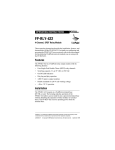

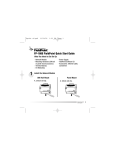
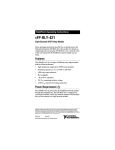

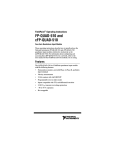
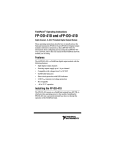
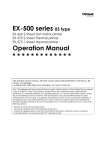


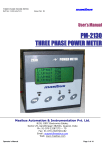
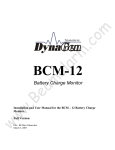
![[c]FP-DO-401 Operating Instructions](http://vs1.manualzilla.com/store/data/005693758_1-4b10a2df6965457ee651014d1377996a-150x150.png)
